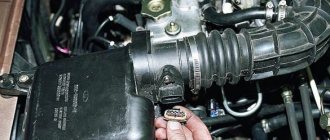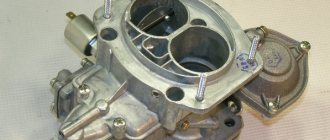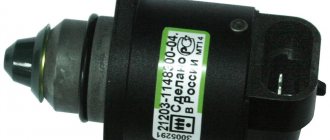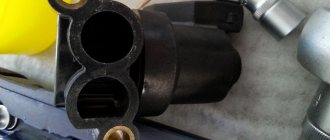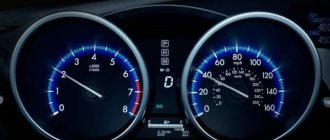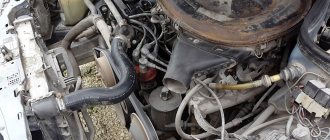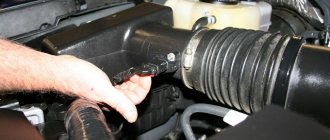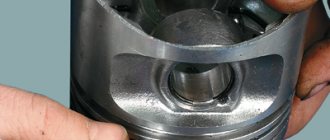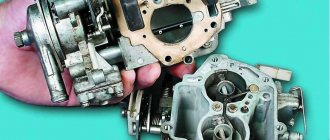Idling is the operation of the device without any load. In a car, the idle speed of the engine is when the clutch is fully depressed. At this time, torque is not transmitted from the crankshaft to the motor and wheels. In this case they are completely disconnected.
Normal idle speed is 800-1000 units. When they decrease, the engine stalls; when the number increases, excessive fuel consumption begins. What speed your car should have is indicated in the operating instructions.
What does idle speed depend on?
The idle speed can be adjusted independently or with the assistance of a specialist. For this purpose, the car has several special units and components. These include:
- fuel system;
- various types of sensors;
- throttle valve;
- idle control valve;
- accelerator pedal.
The fuel system includes an injector or carburetor. These are units in which fuel liquid is mixed with air, forming a combustible mixture. The system includes a fuel pump with a mixture pressure regulator. The operation of the engine fuel supply system is controlled by numerous sensors.
The number of revolutions is also greatly influenced by the position of the throttle valve. It regulates the air supply to the engine. You can increase or decrease the speed by pressing the accelerator pedal.
A car engine may not operate very stable at idle for several reasons:
- contamination of some components;
- problems with the ignition system.
Contamination can be caused by used oil, impurities that pass through filters, soot and water. The ignition system may have oxidized or loose wires.
Why are “idlers” needed?
When the engine is running, power increases exclusively with increasing revolutions, and torque peaks in the region of medium or high speeds (on supercharged units, torque appears earlier, but also not from scratch).
To give the motor a useful load, it must already be spinning steadily and ready to produce torque. Otherwise it will simply stall. There is no way to bypass this limitation. Those speeds at which the motor can take the load are usually called idle. Speeds above idle are working.
For most passenger car engines, the idle speed is 500–900 rpm, which is not so low.
How to change the speed?
Attentive car owners always carefully monitor their car and its condition. This provides significant savings on repairs and fuel consumption, and reduces the risk of breakdowns and accidents. How to reduce engine speed at idle? As already noted, this can be done independently or with the assistance of a specialist. To work you need to prepare:
- standard set of tools;
- new or used clamps;
- gaskets are new.
A cold engine, after turning it on, usually runs at high speeds for some time. After warming up, they drop to the idle speed level, which is 800-1000 rpm. Their exact number is indicated in each vehicle manual. If they do not return to normal, you need to find and fix the problem.
If the car is equipped with a carburetor type engine, then the malfunctions may be as follows:
- misaligned carburetor;
- air leaks in hose connections;
- faulty wiring and idle speed control valve;
- incorrect operation of the ignition system;
- dirty air filter.
The adjustment is quite simple. On an old car you need:
- remove the carburetor and clean it;
- check the functionality of rubber hoses and gaskets;
- replace worn clamps.
A dirty carburetor often causes high idle speed. Therefore, it must be rinsed thoroughly after cleaning. If you do not have your own experience in this matter, it is better to invite a specialist. The hoses can be checked with the engine running by pinching them.
During the procedure, you should carefully listen to the operation of the engine. A change in the number of revolutions indicates that you have found the correct hose. Torn gaskets and loose clamps allow air to enter the engine. This increases the turnover.
It is impossible to mechanically adjust the number of revolutions in an injection engine. They depend on the firmware of the on-board computer. To change them, you need to reflash the idle air control system. Only a specialist can do this. But you should not lower the speed too much, as this will lead to premature wear of the generator.
Before starting operation, you need to check the correctness of the gaps in the gas distribution mechanism, the cleanliness of the air filter, the serviceability of the spark plugs, and the operation of the mixture enrichment valve. Next, prepare a screwdriver with an idle speed adjustment device. It should be used only if other measures taken have not led to the expected result.
The work is carried out in several stages:
- The ignition is turned off, the ends of the device wires are connected in accordance with the technological map attached to it. After this, the engine starts and the rotation speed according to the device is set to 800 rpm using the mixture quantity adjustment screw.
- The next operation is related to the quality screw. By adjusting it, we achieve a CO₂ content in the exhaust gases of no more than 3%.
- Experienced motorists adjust idle speed by ear. They alternately rotate the quantity and quality screws, achieving an even roar of the engine in all modes of its operation.
On engines equipped with an injector, it is sometimes necessary to adjust the idle speed by replacing the idle speed sensor. Changing it is quite simple, having a figured screwdriver in your hands. Sequence of operations:
- You need to purchase a new sensor at your nearest auto parts store;
- open the hood and disconnect the negative terminal of the battery;
- find the old sensor and disconnect the block with wires from it;
- Use a screwdriver to unscrew the mounting screws (2 pcs.) and dismantle the device;
- replace the O-ring and put the new sensor in place;
- tighten the fastening screws and connect the block with wires.
The new sensor should begin its work immediately after starting the engine to regulate the idle speed. Inside this device there is an electric motor and a needle that regulates the flow of air into the engine. The engine speed depends on the amount of air. If necessary, you can start driving even with a cold engine.
How are the speeds regulated?
Now it’s worth touching on the topic of how you can adjust high idle speed on the engine.
Replacing the idle air valve
Do not forget that when starting, the car engine may initially run for a short time at slightly higher idle speeds. When the engine warms up, the speed drops and reaches its normal values. First, you should find out what exactly is considered the norm specifically for your power unit.
If after warming up the speed does not drop, this indicates the presence of one or another malfunction. It must be found and eliminated. Here you should largely rely on the type of engine used.
When the engine has warmed up, but the speed still does not drop, this is considered an abnormal condition. It is imperative to determine why the performance does not return to normal at idle and what is the reason for such high engine speeds.
Some people ignore this advice, which is a big mistake. If you leave the engine in such a state, which will constantly work intensively at idle, the temperature of the internal combustion engine will begin to increase. This will be followed by engine overheating and possible cylinder head deflection. Plus, the formation of friction parts will gradually begin. The service life of the engine will be reduced, and you will speed up major repairs with your own hands or send the engine to a well-deserved rest somewhere in a landfill.
There are several main reasons for the increase in turnover. They are associated with violations and malfunctions in:
- XX regulator sensor;
- throttle position sensor;
- the throttle valve itself;
- temperature sensor;
- ECU;
- the intake manifold, where an air leak has formed.
It is important to note that on carburetor engines you can physically adjust the idle speed. What cannot be done in the case of an injection power unit. But it is possible to eliminate the reasons for the increase in speed at idle. These are different concepts, which should not be forgotten.
Idle mixture adjustment screw
The final (fine) adjustment of the idle air system is made using a special screw with a conical tip, which regulates the throughput of the air channel of the idle air system. Some carburetor models are equipped with a screw that regulates the amount of fuel, already pre-mixed with air, supplied by the idle system.
Idle mixture adjustment screws. Two screws on the left regulate the amount of mixture, two on the right control the composition of the mixture.
Since in one case the screw regulates the composition of the mixture, and in the other - the amount of the fuel mixture, opposite adjustment methods are used. If the screw regulates the throughput of the air channel, then to enrich the mixture it is necessary to reduce the amount of air by tightening the screw. In order to make the mixture leaner, the screw must be unscrewed. If the screw regulates the amount of fuel supplied, then, on the contrary, to enrich it, it is unscrewed, and to become lean, accordingly, it is tightened.
It is very simple to understand by what principle adjustment is carried out on a particular carburetor. The air adjustment screw is located closer to the carburetor inlet, which is connected to the filter, while the fuel adjustment screw is located closer to the engine mounting flange.
Location of the idle mixture adjustment screws: a — mixture adjustment screw, b — mixture amount adjustment screw
Recommendations
Any car enthusiast with experience in repairing Soviet cars knows how many idle speeds should be. Expert advice agrees on one thing: during normal operation of the engine, during cranking, the revolutions remain slightly above 1000, after warming up they drop to 800. If these indicators deviate from those indicated, the first thing they do is try to change gasoline to high-quality one.
It is recommended to check the operation of the spark plugs to ensure that all pistons are involved in the movement of the car. Many owners of domestic cars use spray cans to clean the ignition system. Others resort to old-fashioned methods - adding 50 ml of naphthalene to the tank every time after refueling. EKTO brand gasoline is available for sale from, to which similar additives have already been added.
By choosing the right brand of gasoline, you can save your car from future problems. Practice has shown that additives help keep the ignition system perfectly clean. The opened nodes had no deposits on the walls even after several years.
Multi-position injection system
Idle speed and CO content are usually adjusted automatically using a special device, but there is an option in which the adjustment will have to be done manually. It is best for you to set everything up in a workshop, but if you carefully study the description, then you will be able to adjust the idle speed yourself.
Before adjusting and checking, certain conditions must be met; all parts of the system must be in good condition.
Execution order
- The car is placed on the handbrake, and the wheels are turned to the middle position.
- The battery must be charged.
- The ignition system must work flawlessly, that is, be in excellent condition.
- The coolant and oil levels in engines must correspond to the required values.
- The air intake system must maintain its tightness.
- Compression in the cylinders must maintain the required values.
- The throttle valve must operate perfectly.
- Every single fuse must work.
If you have an automatic transmission, the lever is placed in the neutral position. The air conditioner needs to be turned off.
Optimal mode
However, by 1500 rpm the pump manages to reach its design capacity, pumps lubricating fluid, and wear drops to almost zero. Already at 1800 rpm. all friction units “float” onto oil films, direct contact between the surfaces of the parts disappears, and the wear rate goes to zero. The optimal operating mode of the motor begins.
The production of parts is already so small that it is not recorded by existing instruments. The ideal range of engine operation is from 2000 to 4000 rpm. This is where the maximum torque occurs.
Verdict for the motor. What does the expression “turn up the engine” mean? More details
Injection engines
There are several reasons for increased idle speed in the case of injection engines. At the same time, the injectors do not allow mechanical changes in the number of revolutions, as on carburetor internal combustion engines using the corresponding screws.
Appearance of a fuel-injected car engine
The speed data is included in the on-board computer program. Therefore, to change them, you will have to reflash the ECU and, in particular, the system that is responsible for idling and its control. This can be done exclusively at specialized service stations using professional equipment. Any attempts to get into the ECU settings yourself may end badly.
Before you try to adjust high idle speed on your engine, you should find out the cause of such phenomena. The adjustment itself is carried out depending on what is causing the increase in the number of revolutions in the idle mode.
Problems with the IAC sensor
Here we are talking about the idle speed control sensor on the engine. As you already know, adjustment on carburetors is carried out using two screws, and there is no sensor of this type on such engines.
But in the case of an injector, everything is completely different and even vice versa. An appropriate sensor is used for adjustment. But it doesn’t allow you to change or regulate anything. In fact, the essence of restoring normal idle speed is to remove the sensor, check its current condition, clean the contacts and socket and try to install it in place. If the sensor is completely damaged, the only solution is replacement.
What not to do with a manual transmission
A manual transmission is a reliable type of transmission, but improper operation can significantly reduce its service life and lead to significant damage.
What not to do with a manual transmission:
- engage reverse gear until the car comes to a complete stop (manual transmission failure);
- depress the clutch except for the moments necessary to change gears (increased wear of the release bearing and clutch occurs);
- keep your foot on the clutch pedal while driving (leads to increased wear on the clutch);
- select a high gear (3,4,5) when the speed and low revs are insufficient for this (increased load on the engine and gearbox);
- When stopping for more than 40 seconds, depress the clutch; select neutral gear (increased clutch wear);
- change gears without squeezing the clutch (manual transmission failure);
- constantly keep your hand on the gearshift lever (increased wear of various gearbox mechanisms);
- incomplete clutch release when changing gears;
- dropping the clutch.
If you follow some rules and drive thoughtfully, the experience of driving a car with a manual transmission will come quickly, despite the apparent complexity of such a transmission.
The main advantage of a car with a manual transmission is complete control over it, which is realized only after driving kilometers.
